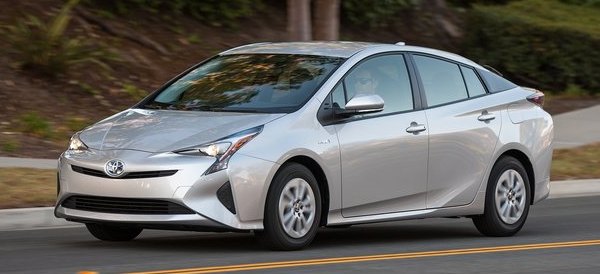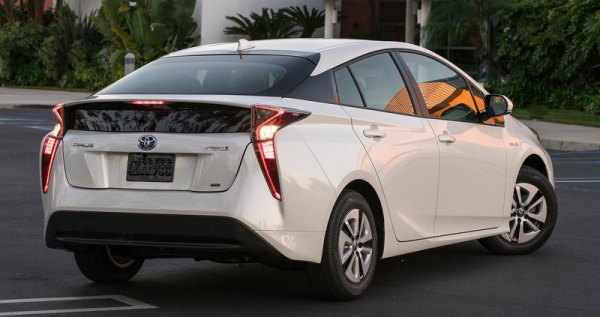|
|
|
Published
on 31
Dec 2015
|
All rights reserved.
|
|
 |
Time passes so
quickly. The first Toyota Prius was launched just a few months after
AutoZine. Now it is in the 4th generation. In the past 18 years, some
3.6 million units have been sold worldwide. The majority of them
belonged to the Mk2 (1.2 million units) and Mk3 (estimated 2.2 million
units). In good years, Toyota could sell 400,000 to 500,000 units a
year, more than many big nameplates. However, since 2011 its sales
performance started declining. Why? Because oil prices dropped
dramatically. More people shifted to SUVs and crossovers. Perhaps
Toyota should build a Prius SUV – if Bentley and Lamborghini can,
why not Prius? No, it is not going to do so, fortunately. Toyota’s
response
is to improve its fuel efficiency further. A strange strategy it might
be, I am glad to see it keeps doing the right thing even though the
rest of the world gets crazy.
A few words sum up the 4th generation Prius: an adventurous styling
matches evolutionary engineering. The new car looks certainly new but
also controversial. Its headlights and taillights are radical to the
extent of over the top. There are a lot of sharp edges and twisted
surfaces so that it looks quite busy, especially around the rear
quarter.
However, this also makes it less MPV-like and more distinctive, unlike
its predecessor. The new body profile gets lower and sleeker at both
ends, while the peak of its roof is moved forward so that it forms a
waterdrop shape, which explains why its Cd is improved further from the
already remarkable 0.25 to
a class-leading 0.24. The whole car is slightly longer (by 60 mm),
wider (15mm) and
lower (20 mm), although its wheelbase is unchanged at 2700 mm.
 |
Toyota stresses that its center of gravity is lowered, thanks in part
to mounting the powertrain 10 mm lower. The front seats are mounted
59 mm lower to create a sportier driving feel while improves headroom.
Rear occupants are not so lucky as the battery and fuel tank take the
space underneath the rear seat. Note that the battery in the last Prius
was mounted in the boot. As it is moved forward, the boot floor can be
lowered. In addition to the longer rear overhang, luggage space is
enlarged from 446 to 502 liters. In other words, it is no longer a
compromise.
As before, the Prius is powered by a 1.8 VVT-i Atkinson-cycle engine in
combination with electric motors and CVT transaxle, the latter two are
integrated and mounted beside the transverse engine. Toyota spent a lot
of effort to improve its fuel efficiency. For example, the engine has
increased EGR and reduced internal friction, boosting its thermal
efficiency from the previous 38.5% to 40%, which matches diesel
engines. The motor and transaxle unit is made smaller, lighter and has
20% friction removed. Likewise, the power control module is made
smaller and more efficient. The battery – still Nickel-Metal Hydride on
standard car, although now extra cash could buy you a 15-kg-lighter
Lithium-ion pack – is also smaller and has higher energy density.
Overall, Toyota claims 10% reduction of fuel consumption compared with
the Mk3. In European terms this means 94 mpg and 70 grams of CO2
per kilometer. US rates it as 54 mpg city and 50 mpg highway.
On the downside, the new car fails to improve performance. The new
engine produces a modest 97 SAE horsepower, actually 1 hp down from the
old engine. The smaller electric motor produces 72 hp instead of the
previous 80 hp. As a result, the combined output of engine and motor
drops from 134 to 122 hp. The car should take 10 seconds and a great
deal of patience to accelerate from 0-60 mph. Its top speed is still
capped at 112 mph.
However, the new car should be still better to drive, thanks to a
significantly improved chassis. Not only the torsion-beam rear
suspension has been replaced with a double-wishbone setup which mirrors
the Mirai, the body shell is massively strengthened by 60 percent in
torsional rigidity, thanks to using more high-strength steel (increased
from 3 to 19%), laser welding, structural adhesives and parts of
varying thickness. The bonnet, tailgate and front crash bar are now
made of aluminum to offset the weight gains of the suspension. In
addition to the lower center of gravity, the car should perform swifter
in corners.
Moreover, the Prius is now available with optional e-4WD for the first
time. In this form, a high-power motor is added to the rear axle to
provide extra power and traction. All these improvements are possible
only because the car sits on the new TNGA (Toyota New Global
Architecture) platform, an equivalent to Volkswagen MQB. It allows
higher flexibility for different configurations hence larger scale of
economy.
On the road, the new Prius is definitely better to drive. There is a
new found precision in its steering and less roll in corners. The
steering is more direct since it is geared 15 percent quicker, although
feel remains largely absent. The combination of independent rear
suspension, stronger chassis and enhanced sound insulation results in a
more composed ride and a quieter cabin. Now you can finally
enjoy the silent operation of its powertrain on less than perfect
surfaces. Meanwhile, Toyota also manages to improve the brake feel. Now
the transition between regenerative and mechanical braking is a lot
more linear and natural. That said, the Prius is still hardly a
driver’s car. It’s handling is more competent than the old car but
still you
will never call it good or exciting. Its performance is mediocre, and
the CVT’s rubber-band effect, although reduced a bit, is not going to
disappear as long as its main objective is to save fuel.
In the cabin, the Mk4 Prius keeps its traditional central instrument
and minimalist design, so it is hardly inspiring. Plastics and
switchgears remain on the cheap side, falling behind the class norm.
Although the amount of space is about the same as before, it feels
larger, thanks to an airier atmosphere created by the slimmer pillars,
lower windscreen cowl and the deletion of floating console.
Apart from the more radical exterior styling, the new Prius is perhaps
too predictable. It follows closely the format set by its predecessors
and only improves things bit by bit. That’s not enough to win new
customers. No wonder Toyota forecasts it will sell 300,000 to 350,000
units annually. In other words, it won’t be as popular as the last
generation. The Prius nameplate deserves a bigger step forward.
|
Verdict:    |
Published
on 7
Oct 2016
|
All rights reserved.
|
|
Prius Prime (Prius Plug-in)
|
|
The plug-in hybrid
version of Toyota Prius is called Prius Prime in America or simply
Prius Plug-in in Europe. It sounds a simple conversion that hardly
raises our interest, but look again and you will find plenty of
interesting changes. First of all, the car looks different. To
accommodate the larger battery, its rear overhang is extended by 80 mm
and this necessitates a styling overhaul. Toyota takes this opportunity
to inject more style, giving it a Zagato-style double-bubble rear
hatch, whose frame is made of carbon-fiber to save weight but the
screen is real glass, unlike the polycarbonate items on many Aston
Martin Zagatos (considering its production volume, Toyota has no
problem to afford the cost of bespoke glass). Up front, the Prius’ nose
is also smartened up with a black fascia and Mirai-style quad-LED
headlights. This car still looks strange – perhaps even stranger – from
my conservative taste, but it does stand out from the crowd.
Under the rear seat and cargo floor, there is now an 8.8 kWh lithium
battery, versus 0.7 kWh of the regular Prius or 4.4 kWh of the last
generation Prius Plug-in (which was a sale flop, btw). It gives the car
an EV-range of 25 miles or 40 km before needing the intervention of
petrol engine. The 1.8-liter engine remains the same, as are the hybrid
system’s 2 electric motors. However, while the regular Prius uses only
the larger motor for propulsion and the smaller one for starting and
regeneration, the Prime can use the latter for propulsion also, thanks
to the addition of a one-way clutch. As a result, the electric power is
boosted by 20 hp, although combined maximum output remains unchanged at
122 hp because the smaller motor gives up working earlier. The car can
run on stored electricity alone at up to 84 mph, covering the majority
of driving situations. Nevertheless, as the car gains 150 kg of weight,
its 0-60 mph acceleration gets slightly worse at about 11 seconds.
On the road, as long as the battery is not depleted, the Prime provides
enough punch and performance to satisfy most driving needs. Built on
the TNGA platform, its ride and handling are also much more decent than
any previous Prius. In fact, with more time to fine tune the chassis,
it drives better than the Prius hybrid. The steering feels more
naturally weighted. The ride seems more compliant. Although there is
still more pitch and roll than desired, the car feels agile enough to
go head to head with most family cars.
Inside, the Prime loses the middle rear seat and 142 liters of luggage
space due to the larger battery. It is not as practical as the regular
Prius, of course, but in return you get a more upmarket, 11.6-inch
portrait touchscreen at the center console. Moreover, the plug-in
hybrid remains economically viable like all Prius do. It is
significantly cheaper than Chevrolet Volt yet returns lower fuel
consumption. The only concern is how much Toyota will charge for
repairing the carbon-fiber hatch in case it is damaged by rear
collision. This is the best Prius so far, if still not something we
would choose over a Passat, a Fusion or Mazda 6.
|
Verdict:    |
|
|
|
|
|
|
|
|
|
|
Prius
|
2015
|
| Front-engined,
FWD |
| Steel monocoque |
| Mainly steel |
| 4540 / 1760 / 1470 mm |
| 2700 mm |
Inline-4, Atkinson-cycle + electric
motor
|
1797 c.c.
|
DOHC 16 valves, VVT
|
| - |
| - |
98 hp + 72 hp = 122 hp
|
105 lbft + 120 lbft
|
CVT
|
F: strut
R: double-wishbones
|
-
|
195/65R15 or 215/45R17
|
1380 kg
|
112 mph (limited)
|
10.0 (c) / 10.5* / 11.1**
|
31.4* / 32.0**
|
|
Prius
Prime
|
2016
|
| Front-engined,
FWD |
| Steel monocoque |
| Mainly steel |
| 4645 / 1760 / 1470 mm |
| 2700 mm |
Inline-4, Atkinson-cycle + electric
motor
|
1797 c.c.
|
DOHC 16 valves, VVT
|
| - |
| - |
| 98 hp + 92 hp = 122 hp |
| 105 lbft + 120 lbft |
CVT
|
F: strut
R: double-wishbones
|
-
|
195/65R15
|
1530 kg
|
112 mph (limited)
|
10.2*
|
30.7*
|
|
|
|
|
|
|
Performance
tested by: *C&D, **Autocar
|
|
|
|
|
|
|
|
|
Copyright©
1997-2016
by Mark Wan @ AutoZine
|
|